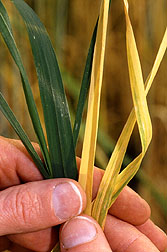Faster ID of Wheat Resistant to BYD Virus
A more rapid way to screen for wheat that contains a disease-resistance gene borrowed from a wild relative has been developed by Agricultural Research Service scientists.
Joseph M. Anderson, a molecular biologist at the ARS Crop Production and Pest Control Research Laboratory in West Lafayette, Indiana, worked with Purdue University researchers to find a rapid genetic test for resistance to barley yellow dwarf virus (BYDV). Their research may help plant breeders more quickly develop resistant crop varieties.
And the faster the better--because the virus continues to attack small grains worldwide, including wheat, rye, barley, and oats.
The virus is carried by aphids that inject it into the plant as they feed. Infected plants develop yellow leaves and become dwarfed or stunted. Yield loss varies widely--from 5 to 80 percent. While barley and oats have some natural resistance to the virus, domestic wheat varieties contain none.
Hoping to genetically add BYDV resistance to wheat, Purdue University agronomists Hari C. Sharma and Herbert W. Ohm transferred a chromosome from wheatgrass into wheat plants. Wheatgrass is naturally resistant to this virus.
But the problem with this approach, the scientists say, is that an entire wheatgrass chromosome is too much.
|
|
"The whole chromosome may affect other properties of wheat, such as grain yield and milling and baking quality of the flour, or it may increase the time from planting to harvest," Anderson says. "We want to use only enough of the chromosome to get the disease resistance."
Finding the right amount of chromosome has been difficult. Traditional methods of screening for specific genetic traits included visually examining plants for desired traits. But that didn't tell scientists enough about the plant's genetic makeup.
Other, more time-consuming methods--such as additional crossbreeding and culling of weaker hybrids and testing for virus resistance through aphid inoculation and antibody activity--were needed to determine which plants displayed the desired traits.
Ultimately, to identify those wheat lines that contained a small piece of the wheatgrass chromosome, laboratory technicians had to use complex molecular biology techniques to examine their chromosomal structure. Once they identified plants containing fragments of the chromosome, they then used those lines to develop resistant varieties. The process typically took several years and wasn't always successful.
To speed it up, ARS scientists devised a polymerase chain reaction (PCR) test that used a molecular marker--a piece of genetic material, or DNA, from the wheatgrass chromosome--to distinguish plants with a piece of the chromosome.
Use of the PCR test to show which plants contain wheatgrass DNA and then characterizing these plants genetically has greatly increased the accuracy and frequency of finding the plants with just a portion of the wheatgrass chromosome, says Anderson.
"In this case, we've had success 33 percent of the time using PCR testing, versus 4 percent with older methods," he says. "This test is very fast. It allows us to determine in just a few hours whether a plant contains the desired DNA."
|
|
Here's how the test works. After scientists find a sequence of DNA located near the disease-resistance gene, they clone, or copy, it and then take segments to use in the PCR test. These DNA segments are added to DNA of plants the scientists think might be carriers of the wheatgrass chromosome with the BYDV resistance trait. Since these segments will bind only to the DNA of the wheatgrass chromosome, scientists know that when that happens, they have detected wheatgrass DNA in a wheat plant.
Using this rapid technique, Anderson and his coworkers have identified several wheat lines that are virus resistant and carry only a small portion of the wheatgrass chromosome. These lines are currently being incorporated into the Purdue University wheat-breeding program to develop high-quality BYDV-resistant wheat varieties.
"The beauty of this PCR test is that it can also be used to select virus-resistant lines without going through the very time-consuming, labor-intensive, and expensive inoculation and antibody testing that was required in the past," says Anderson.
The upshot: more rapid selection of potentially resistant elite lines by plant breeders.
"We can easily screen several hundred samples in a day using the PCR test, compared to 100 samples in 3 or 4 weeks," Anderson says.
Faster identification of plants with disease resistance also means more field samples can be screened.
"We can have faster and more accurate evaluation of actual varieties growing in the field using rapid testing. This is a significant change over the traditional methods that required two or more seasons of crop growth before we could determine which plants to include in subsequent breeding programs."--By Dawn Lyons-Johnson, Agricultural Research Service Information Staff.
Joseph M. Anderson is at the USDA-ARS Crop Production and Pest Control Research Laboratory, Lilly Hall of Life Sciences Building, Purdue University, West Lafayette, IN 47907; phone (765) 494-5565; fax (765) 496-3452.
"Faster ID of Wheat Resistant to BYD Virus" was published in the June 1998 issue of Agricultural Research magazine. Click here to see this issue's table of contents.









